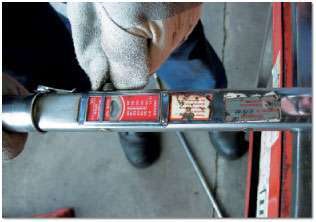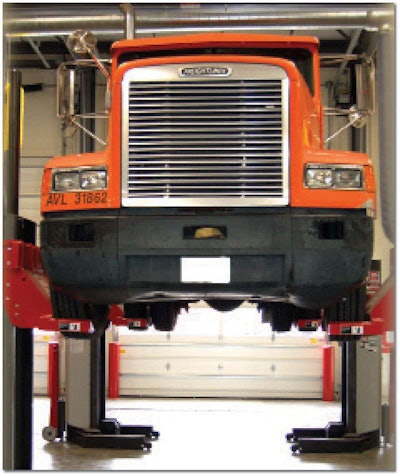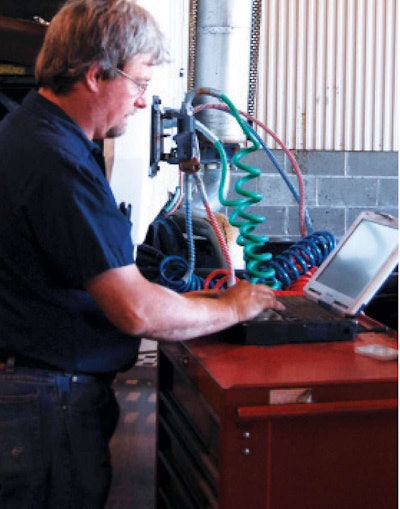If you can’t measure it, you can’t monitor it. If you can’t monitor it, you can’t improve it. If you can’t improve it, you likely won’t be able to increase profitability. Knowing what to measure is the first step, but knowing what to do with all those numbers delivers positive changes you not only can measure, but these also can improve your profitability.
Chances are, no matter how productive and efficient you think your service shop is, it can be improved. But you won’t know that until you take an honest, systematic look at all areas of your operation. The collection of these metrics is fundamental to being able to make changes that result in improvements and a healthier bottom line.
Metrics can be overwhelming, but when taken correctly, they provide X-ray vision into a shop, showing areas of weakness in sharp relief. Closely measuring efficiency at points of information transfer and communication – such as between customers and service writers, and between technicians and parts employees – is almost guaranteed to highlight points where costs can be cut, sometimes dramatically.
When considering metrics, don’t get overwhelmed; not all the measurements need to be taken immediately and not all changes must be implemented at once. Small steps carefully considered are far better than taking a reckless leap. The following are some key measurements you should consider and ways metrics can be used to analyze your businesses and implement enduring positive changes. It is by no means an exhaustive list, but these metrics are good starting points to see how efficiently and effectively the service department is running.
NO MAGIC NUMBER
Most industries love benchmarks, but these numerical standards can be crippling. You shouldn’t use service metrics just to see if you’re hitting a generic benchmark. Too often, measurements are taken infrequently and if they look good, they’re not revisited on a regular basis. This is a huge mistake.
 A clean, orderly service department not only presents a professional look to customers, it helps maximize productivity and employee morale.
A clean, orderly service department not only presents a professional look to customers, it helps maximize productivity and employee morale.One benchmark that Keith Ely & Associates, a consulting company focusing on the trucking industry, uses measures the number of tickets an advisor should be able to write in a day. They feel that hitting a number of about 80 hours a day or 15 tickets a day is a good place to be, but caution that there’s no such thing as a magic number.
“It’s really about continuous improvement, not about trying to hit some industry benchmark,” says Mark Martincic, dealership operations professional advisor, Keith Ely & Associates.
“First of all, if you hit the benchmark, you’re average,” Martincic continues. “More importantly, too often I’ve seen managers look at a benchmark and instead of coaching their people, training them to improve, they just replace them. That doesn’t do anything. Every service department is set up differently. Their processes are different and the number of support people they have varies, as does the physical layout of the facility. You have to quantify all of that when you’re looking at those [benchmarks].”
Focusing too closely on one number warps a manager’s bird’s eye view of the service department. Firing an employee just to trim some fat off your financial statements can come back to haunt you when your business picks up. If you feel that you’re losing money in one area, take the time to examine the processes you have in place before letting people go.
We live in a pre-packaged, ready-to-wear era and that ideology often permeates business. Industry benchmarks are neat, convenient and ready to go. Disregarding industry benchmarks entirely isn’t prudent because they act as rough guidelines with which you can steer your department, but far more valuable are an individualized set of benchmarks, tailored to your particular service department.
And even more valuable than those numbers is the positive or negative change frequent measurement can show. When done right, metrics are a barometer that enables you to be nimble and make changes to your service operation that add to your bottom line.
SERVICE WRITER = SALESMAN
A service writer is a critical point of contact between your company and your customer, yet they often don’t get the kind of training a salesperson receives. A service writer, however, is truly in a make it or break it position. Are they upselling your customers or just processing the repair order (RO) and calling it a day? Measuring a service writer’s efficiency and effectiveness is critical; what you find may enable you to dramatically increase sales.
“There is a significant process hole that starts with how a truck gets written up for service and how complicated that is in terms of figuring out all the information that’s necessary or that should be available during the write-up process,” says Dick Hyatt, president and CEO of Decisiv, a service management platform provider for the medium- and heavy-duty truck market.
“The platforms out there today do a great job of capturing what was done after the repair order was written,” says Jack Porter, senior consultant at Decisiv and former vice president of Valley Freightliner, Seattle. “The problem is with the start of that process. It’s really broken.”
Porter and Hyatt see immense value in being able to measure a service writer’s performance. “The service writer actually has more contact with their customers than anybody in the dealership network,” says Porter. “You must give them the tools to become good salespeople and also be a consultant for the customers who have their trucks in the shop for repairs.”
The service writer should have the ability to access all the tools and information needed to make quick decisions for a customer. If the service writer’s performance isn’t up to par, it might be time to reassess what kind of tools you’re giving him to get the job done efficiently.
Again, these measurements must be taken often and consistently to provide a definitive snapshot of efficiency.
After all, your customers’ profitability is directly impacted by your ability to get their trucks repaired and back on the road quickly. “Those trucks make money by the hour and there’s a lot of demand on the service writer and the service department to make sure that they get that utilization through their shop,” says Porter.
Another useful metric when gauging a service writer’s efficiency and salesmanship is how many ROs have only one item on them. If most of your ROs are for one item, it’s time to talk to your service writer about upselling.
“The most difficult thing that we can do is increase the number of ROs being written,” says Keith Ely, managing partner, Keith Ely & Associates. Once you have a customer in the door, most of your work is done – but there still are more sales opportunities to be harvested.
“When we go into a store and start looking at ROs, we see a lot of what we term as one item ROs where we’ve fixed one thing on a customer’s truck,” says Martincic. “We know that if we fixed only one item, we didn’t sell anything.”
 When technicians are looking for misplaced or inconveniently stored tools, they’re not making money. Specialized and commonly used tools should be kept nearest the technicians that use them most.
When technicians are looking for misplaced or inconveniently stored tools, they’re not making money. Specialized and commonly used tools should be kept nearest the technicians that use them most.A good service writer also should have a finger on the pulse of the service department. This will help him effectively upsell and schedule service without causing headaches for technicians.
“The service writer should know what the status of the service department is,” says Mike Conroy, director of dealer development, Peterbilt. “Knowing the scheduling of your service operation based on each hour in the day so [the service writer] can prioritize jobs in each bay for each technician is really the key to efficiency.”
“We believe strongly that people buy with four things in mind: Quality, convenience, service and price,” says Martincic. “But convenience is really what [the service writer] is selling. The customer can’t make money with the truck in the shop. If it’s in the shop waiting on a widget anyway and it needs brakes, if we can take care of that and get it back to the customer without making him take another trip, that’s what he’s buying at that point: Convenience.”
Of course, a customer always must be made aware of any work that’s done on his truck before it’s performed, but finding other repairs and selling them to the customer within the framework of convenience is a way service writers can improve their effectiveness. Taking a look at how many one-item ROs pass through the service department can shed light on an often-overlooked way to boost sales.
GAUGING YOUR TECHNICIAN SITUATION
You shouldn’t need to take any measurements to know that the communication between the parts and service departments always could be better. But putting a number on the inefficiencies at that juncture may yield surprising results.
 The service writer should be a salesman. If a vehicle is waiting on a part, use the opportunity to upsell the customer preventive maintenance or other needed work. It will save them a trip down the road.
The service writer should be a salesman. If a vehicle is waiting on a part, use the opportunity to upsell the customer preventive maintenance or other needed work. It will save them a trip down the road.“A recent study that we performed at a dealership revealed that $125,000 per year in revenue was lost because of inefficiencies between those two departments,” says Kent Ely, customer services manager, Keith Ely & Associates. “In this study, we looked to answer questions such as: How much time do technicians spend walking to and from the service parts counter? And once they get to the parts counter, how long must they wait to be served by the parts counterperson, as well as how long must they wait for the part itself? Finally, is the parts counter also used as a place for technicians to congregate, resulting in the shop not running as efficiently as possible?”
Finding the answers to these questions as well as ensuring that you have technicians assigned to jobs that best match their skill levels (for example, you wouldn’t want to have a highly skilled, highly paid tech performing PM work) are some of the most important service metrics you can accumulate.
There is perhaps nothing more aggravating for a manager than the sight of technicians out of the bays, gathered at the back parts counter. Documenting how much time and why technicians are out of their bays will help a manager prevent this money-draining situation from occurring.
“The first thing I do is park myself at the back parts counter, making myself as non-descript as possible and observing what’s going on,” says Kent Ely. “Parts guys think that I’m looking at them, but I’m actually looking at the technicians’ behavior when they’re up there.” Ely completed a two-hour study and found that 35 minutes were lost because of technicians waiting at the counter.
“It doesn’t seem like much, but by the time you go through all the factors of effective labor rates and hours open, that loss forecasted over the year is $135,000,” says Kent Ely. “Are you going to get it all back? Probably not. Can you recoup a significant amount? By all means.”
Another way to track time spent out of the bay is by having technicians clock in and out every time they leave the bay, providing a reason for the absence, whether it is to get a tool, take a break or anything else.
 Having technicians order parts from their bay that are delivered by a parts runner is one strategy that maximizes billable service work.
Having technicians order parts from their bay that are delivered by a parts runner is one strategy that maximizes billable service work.“What I’ve seen is that the managers who try that on a regular basis are given a lot of information about why technicians are not in bays earning money,” says Conroy. “It then leads the dealer to make changes in both the work assignment to the technician as well as to the layout of the service department.”
Use these metrics to rethink both the information flow and physical layout of the service department. Would it be better to have technicians order parts from their bays and have a parts runner deliver them? Could you implement a system whereby a technician could draw the attention of a service writer or manager using a signal from the bay? No one answer fits every shop, but trying new systems and measuring the results to see how they stack up against the old ways is a sure step toward finding the right solution for your service department.
TAKE A CUSTOMER PERSPECTIVE
When considering service department metrics, managers run the risk of becoming so internally focused that they forget that what’s really important is how they measure up in the customers’ eyes.
“There are so many critical measurements internal to our operations…But the key measurement external to us is customer satisfaction,” says Conroy. “Was a customer satisfied? Will he return for more service work or promote our department?”
Another way to measure yourself is to evaluate your pricing model. Are you quoting prices based on a job or on hours worked? Are you actively promoting competitive specials that might draw new customers in or keep old customers loyal?
Advertising a special PM package, a winterization special or a complimentary multi-point inspection can help draw customers to your service department. A multi-point inspection has the added bonus of being a valuable selling tool. If a technician performs the inspection before servicing the vehicle, the opportunity is there to suggest additional needed repairs to the customer while the truck is already in the shop.
Once you start measuring efficiency and effectiveness in the service department, you’ll find more things to measure than you likely ever thought possible. Measuring elements like the way communication flows through the authorization process or customer and warranty approvals can show you many ways in which you might be able to make small changes that add up to more satisfied service department employees and big savings. n
Return on Technician Investment
It can be hard to put numerical values on technicians themselves, but doing so can provide insight into service department performance and show you how it can be made more efficient. The following calculations may be helpful for a service manager.
“A strong measure of departmental performance is return on technician investment,” says Kent Ely, customer services manager, Keith Ely & Associates. “The calculation is as follows: Labor Gross Profit (do not include sublet; this gross profit can be the total for department by shift, by team, by service writer, by individual tech, etc.) divided by total hours available for work by technicians being measured (i.e. all technicians, technicians on a shift, individual technicians, etc.).
“This measure will present the labor gross profit generated per hour of available time (not hours billed or hours on a repair order). The hours available are the investment for the service department.
“The guide is as follows: Effective Labor Rate target (by department, shift, tech, writer, etc.) multiplied by 72 percent gross profit margin multiplied by 110 percent technician proficiency.”
Measuring the Value of Organization
Once you start measuring service department performance, you might find a technician’s valuable time too often is being spent looking around the shop for a certain tool or trying to find the keys for a customer’s truck. Taking the time to put your shop in order and to create organizational systems that make sense for employees is time well spent.
“No one likes to go into a house of disarray,” says Mike Conroy, director of dealer development, Peterbilt. “A tool we utilize internally at Peterbilt is the Five S’s, which are standards of cleanliness and orderliness.”
According to Conroy, the S’s stand for sorting, setting in order (everything has a place), sweeping and shining, standardization and sustaining.
“I think it’s very transferable to our dealers and it presents an image to our employees and customers of orderliness, cleanliness and efficiency,” says Conroy. “This is effective, yet not costly.”
“The physical environment that technicians work in has a direct effect on the jobs they perform for the customer each day,” says Kent Ely, customer services manager, Keith Ely & Associates. “Are shop tools located in an area that is readily accessible to the technicians who use them on a daily basis? Is the shop congested or can technicians easily navigate the floor to get what they need and return to the bay to continue working? It may not seem like a lot of time is being lost, but over time the savings can be significant through having an organized system for where shop tools are housed.”
Another common and costly time drain in shops is time spent by a technician moving trucks around the lot. This situation can be remedied by developing a systemized process for moving and parking trucks that works for your unique facility layout.
“Beginning with truck keys that are not put in the correct location after the initial write up to needing to move other trucks to bring another into the shop, inefficiency in this process can add up to a large sum of dollars over the course of the year,” says Ely.
All the minutes lost at the expense of disorganization can add up to significant financial losses when all is said and done. Measuring the time lost in a disorganized service department then taking steps to mitigate those losses might give you a surprisingly large return on your time invested.







